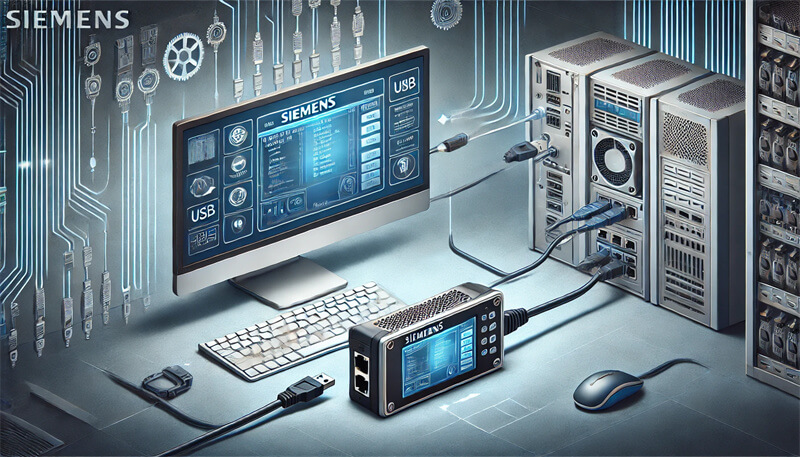Key Takeaways Table
| Question | Answer |
|---|---|
| What is Siemens HMI? | Siemens HMI (Human Machine Interface) is a device used in industrial automation for control and monitoring. |
| Why connect Siemens HMI to a PC? | For enhanced control, simplified configuration, and effective monitoring. |
| What are the connection methods? | USB and Ethernet connections are the primary methods. |
| What software is needed? | Siemens TIA Portal software and appropriate drivers. |
| Common troubleshooting tips? | Check cables, drivers, and network settings; refer to the troubleshooting section for more. |
Introduction
Siemens HMI (Human Machine Interface) is an essential component in industrial automation, providing operators with an interface to control and monitor machinery. Established in 2013, ControlNexus is a leading provider of Siemens PLCs, HMIs, and Inverters. Connecting your Siemens HMI to a PC is crucial for efficient configuration and monitoring. This comprehensive guide will walk you through the process step-by-step, ensuring a successful connection.
Understanding Siemens HMI
What is Siemens HMI?
Siemens HMI devices are integral to modern industrial systems, offering a user-friendly interface for monitoring and controlling equipment. They come in various models, each designed to cater to specific industrial needs.
Benefits of Connecting HMI to PC
Connecting Siemens HMI to a PC offers several advantages:
- Enhanced Control: Greater flexibility in managing and adjusting settings.
- Simplified Configuration: Easier setup and programming.
- Effective Monitoring: Real-time data visualization and diagnostics.
Preparing for Connection
Requirements and Prerequisites
Before beginning the connection process, ensure you have the following:
- Hardware: Appropriate cables (USB or Ethernet) and connectors.
- Software: Siemens TIA Portal software and relevant drivers. You can find more about Siemens software here.
Safety and Precautions
To prevent any damage to your equipment or personal injury, follow these safety precautions:
- Power Off: Ensure all devices are powered off before connecting.
- Check Cables: Verify that all cables and connectors are in good condition.
- Static Precautions: Use anti-static measures to avoid damage to electronic components.
Step-by-Step Connection Guide
Method 1: USB Connection
Step 1: Installing Necessary Drivers
Install the required drivers from the Siemens website or the TIA Portal software package. Proper driver installation is crucial for the system to recognize the HMI device.
Step 2: Connecting the HMI to the PC via USB
- Power off both devices.
- Connect one end of the USB cable to the Siemens HMI and the other end to the PC.
- Power on the PC, followed by the HMI.
Step 3: Configuring the Connection Settings
Open the TIA Portal software and navigate to the HMI configuration section. Select the USB connection option and configure the settings as per the device specifications.
Step 4: Verifying the Connection
Once configured, verify the connection by checking the communication status in the TIA Portal. The HMI should be recognized and ready for further configuration.
Method 2: Ethernet Connection
Step 1: Setting Up the Network
Ensure your network infrastructure is in place, including routers and switches, if necessary.
Step 2: Connecting the HMI to the PC via Ethernet
- Power off both devices.
- Connect an Ethernet cable between the HMI and the PC, or through a network switch.
- Power on the network switch (if used), followed by the PC and the HMI.
Step 3: Configuring IP Addresses and Network Settings
In the TIA Portal software, navigate to the network settings. Assign IP addresses to both the PC and the HMI, ensuring they are on the same subnet.
Step 4: Testing the Network Connection
Test the network connection by pinging the HMI from the PC. If successful, proceed with the configuration in the TIA Portal software.
Detailed Configuration and Troubleshooting
Configuring Siemens HMI Using TIA Portal
Once your Siemens HMI is connected to the PC, you can configure it using Siemens TIA Portal software. Here's a step-by-step guide:
- Open TIA Portal: Launch the TIA Portal software on your PC.
- Create a New Project: Go to the 'Projects' tab and click on 'Create New Project'.
- Add HMI Device: In the project view, select 'Add New Device' and choose your Siemens HMI model.
- Set Parameters: Configure the device parameters, including IP address (for Ethernet connections) and device name.
- Upload Project to HMI: Once the configuration is complete, upload the project to the HMI by selecting 'Compile and Download'.
Here are some helpful resources to guide you through the TIA Portal setup:
- Mastering Siemens PLC Programming: A Comprehensive Guide to TIA Portal
- Comprehensive Guide to Connecting Your Siemens PLC with an HMI
Common Issues and Solutions
Even with a detailed guide, you might encounter some common issues. Here are a few troubleshooting tips:
- Device Not Recognized: Ensure that all drivers are correctly installed. Reconnect the USB or Ethernet cable and reboot both devices.
- Network Issues: Verify that IP addresses are correctly configured and that both devices are on the same subnet. Use the 'Ping' command to check network connectivity.
- Software Errors: Make sure you are using the latest version of TIA Portal software. Check Siemens support for updates and patches.
For more detailed troubleshooting, refer to:
Expert Tips and Real-World Examples
Expert Advice
Gaining insights from experienced Siemens HMI users can significantly enhance your setup and configuration process. Here are some expert tips:
- Regular Updates: Keep your software and firmware up-to-date to avoid compatibility issues.
- Backup Configurations: Regularly backup your HMI configurations to prevent data loss.
- Use Quality Cables: Ensure you are using high-quality USB and Ethernet cables to avoid connectivity issues.
Real-World Connection Scenarios
Here are some practical examples of Siemens HMI connections in various industries:
- Manufacturing Plant: A manufacturing plant uses Siemens HMI connected to multiple PCs for real-time monitoring and control of production lines.
- Water Treatment Facility: Siemens HMI is connected via Ethernet to a central control system to manage water treatment processes efficiently.
- Automotive Industry: An automotive factory utilizes Siemens HMI for robotic assembly lines, ensuring precise control and monitoring.
These examples demonstrate the versatility and efficiency of Siemens HMI in different industrial settings. For more case studies, visit:
Frequently Asked Questions (FAQs)
What software is needed to connect Siemens HMI to a PC?
You will need Siemens TIA Portal software and the appropriate drivers for your HMI model.
How do I troubleshoot connection issues?
Common troubleshooting steps include checking cables, verifying IP addresses, ensuring drivers are installed, and using the 'Ping' command to test network connectivity.
Can I connect Siemens HMI to multiple PCs?
Yes, Siemens HMI can be connected to multiple PCs, typically via an Ethernet network, allowing for centralized control and monitoring.
For more frequently asked questions, visit:
Conclusion
Connecting your Siemens HMI to a PC is a vital step in ensuring effective control and monitoring of your industrial processes. By following this comprehensive guide, you can achieve a successful connection and optimize your HMI's performance. For more detailed guides and expert tips, explore the wide range of resources available at ControlNexus.




One Response
Thanks for ones marvelous posting! I definitely enjoyed reading it, you might be a great
author.I will be sure to bookmark your blog and definitely will come back sometime soon. I
want to encourage you to ultimately continue your great work,
have a nice evening!